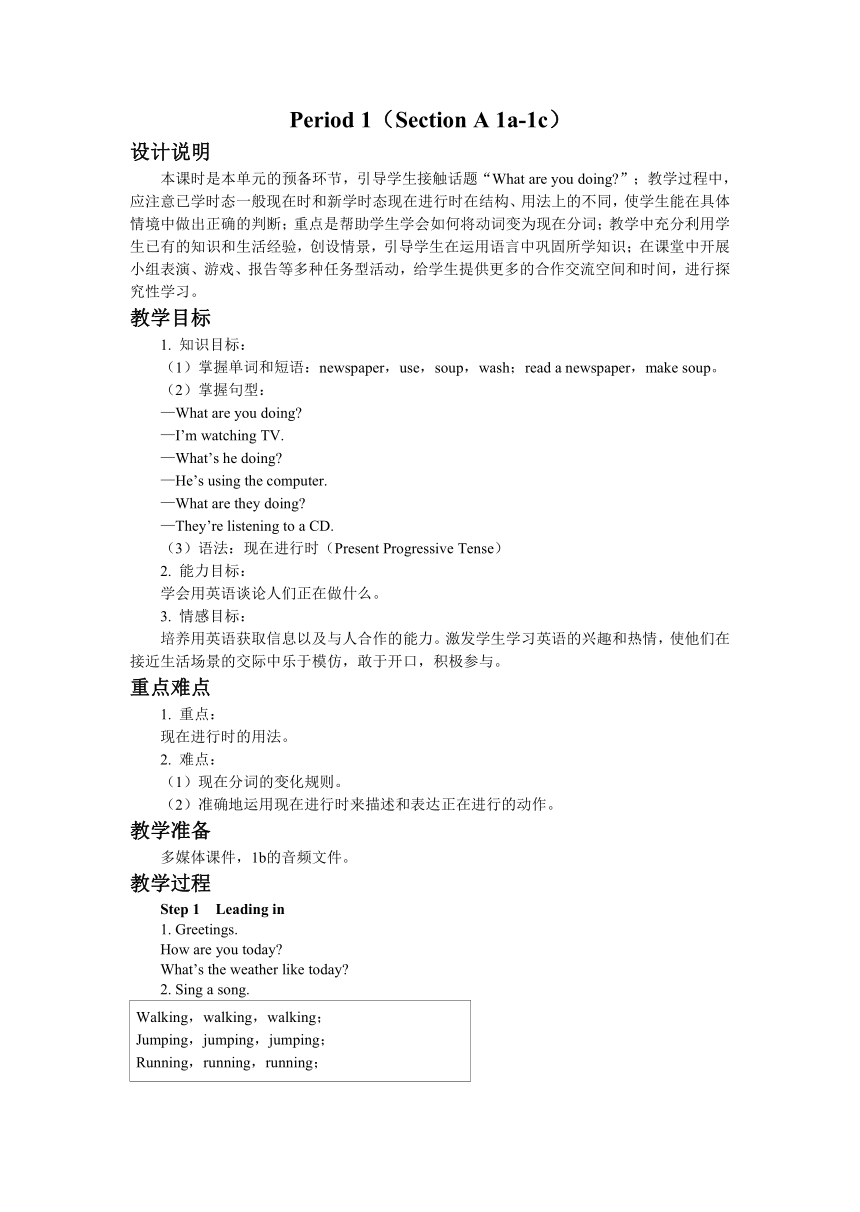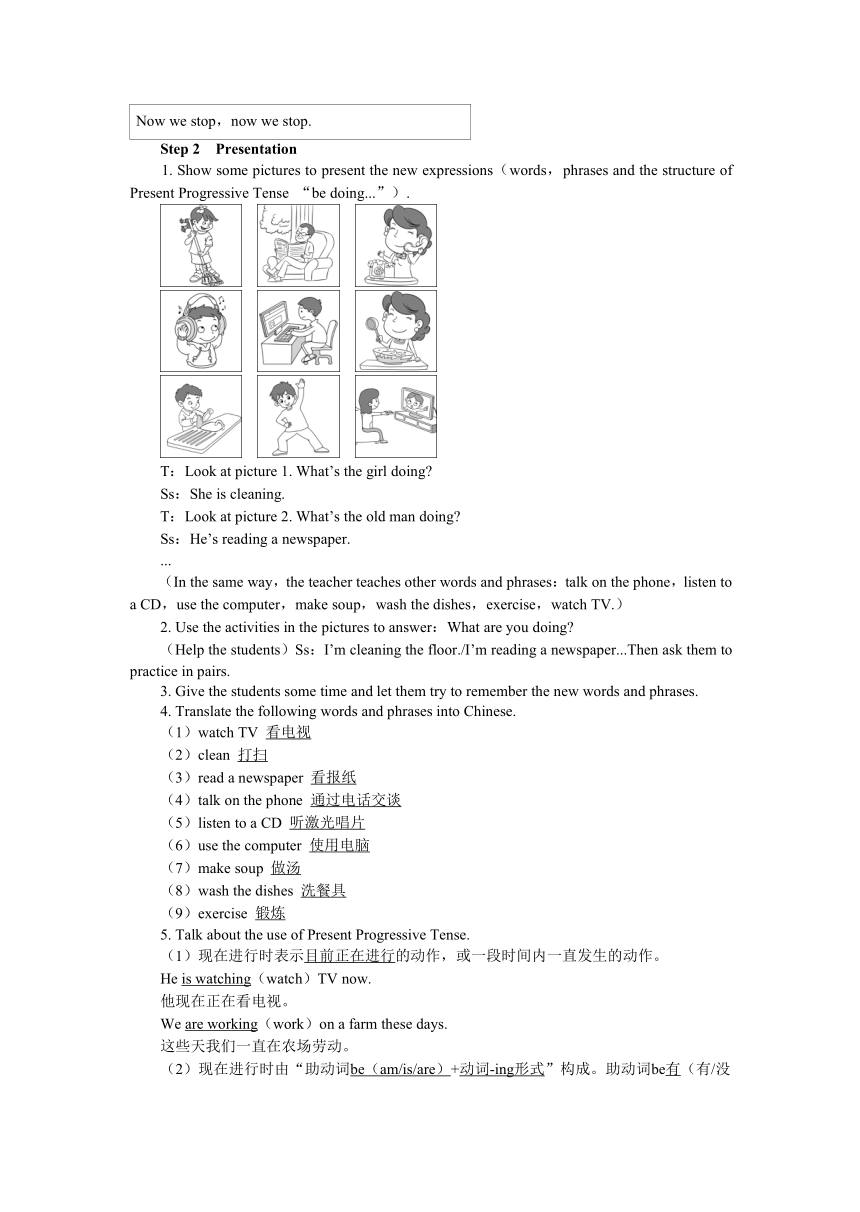教学详案 --人教版中学英语七年级(下)UNIT 6 Period 1 (Section A 1a-1c)
文档属性
| 名称 | 教学详案 --人教版中学英语七年级(下)UNIT 6 Period 1 (Section A 1a-1c) |  | |
| 格式 | docx | ||
| 文件大小 | 386.0KB | ||
| 资源类型 | 试卷 | ||
| 版本资源 | 人教新目标(Go for it)版 | ||
| 科目 | 英语 | ||
| 更新时间 | 2024-02-21 19:48:23 | ||
图片预览


文档简介
Period 1(Section A 1a-1c)
设计说明
本课时是本单元的预备环节,引导学生接触话题“What are you doing ”;教学过程中,应注意已学时态一般现在时和新学时态现在进行时在结构、用法上的不同,使学生能在具体情境中做出正确的判断;重点是帮助学生学会如何将动词变为现在分词;教学中充分利用学生已有的知识和生活经验,创设情景,引导学生在运用语言中巩固所学知识;在课堂中开展小组表演、游戏、报告等多种任务型活动,给学生提供更多的合作交流空间和时间,进行探究性学习。
教学目标
1. 知识目标:
(1)掌握单词和短语:newspaper,use,soup,wash;read a newspaper,make soup。
(2)掌握句型:
—What are you doing
—I’m watching TV.
—What’s he doing
—He’s using the computer.
—What are they doing
—They’re listening to a CD.
(3)语法:现在进行时(Present Progressive Tense)
2. 能力目标:
学会用英语谈论人们正在做什么。
3. 情感目标:
培养用英语获取信息以及与人合作的能力。激发学生学习英语的兴趣和热情,使他们在接近生活场景的交际中乐于模仿,敢于开口,积极参与。
重点难点
1. 重点:
现在进行时的用法。
2. 难点:
(1)现在分词的变化规则。
(2)准确地运用现在进行时来描述和表达正在进行的动作。
教学准备
多媒体课件,1b的音频文件。
教学过程
Step 1 Leading in
1. Greetings.
How are you today
What’s the weather like today
2. Sing a song.
Walking,walking,walking; Jumping,jumping,jumping; Running,running,running; Now we stop,now we stop.
Step 2 Presentation
1. Show some pictures to present the new expressions(words,phrases and the structure of Present Progressive Tense “be doing...”).
T:Look at picture 1. What’s the girl doing
Ss:She is cleaning.
T:Look at picture 2. What’s the old man doing
Ss:He’s reading a newspaper.
...
(In the same way,the teacher teaches other words and phrases:talk on the phone,listen to a CD,use the computer,make soup,wash the dishes,exercise,watch TV.)
2. Use the activities in the pictures to answer:What are you doing
(Help the students)Ss:I’m cleaning the floor./I’m reading a newspaper...Then ask them to practice in pairs.
3. Give the students some time and let them try to remember the new words and phrases.
4. Translate the following words and phrases into Chinese.
(1)watch TV 看电视
(2)clean 打扫
(3)read a newspaper 看报纸
(4)talk on the phone 通过电话交谈
(5)listen to a CD 听激光唱片
(6)use the computer 使用电脑
(7)make soup 做汤
(8)wash the dishes 洗餐具
(9)exercise 锻炼
5. Talk about the use of Present Progressive Tense.
(1)现在进行时表示目前正在进行的动作,或一段时间内一直发生的动作。
He is watching(watch)TV now.
他现在正在看电视。
We are working(work)on a farm these days.
这些天我们一直在农场劳动。
(2)现在进行时由“助动词be(am/is/are)+动词-ing形式”构成。助动词be有(有/没有)人称和数的变化,变化规则与be作连系动词时相同(相同/不相同)。
I am reading. He is watching TV. They are working.
6. Show the words adding “-ing” and ask the students to read the words and then ask them to talk about the rules.
(1)play→playing do→doing eat→eating
talk→talking watch→watching tell→telling
clean→cleaning read→reading
此类动词-ing形式的变化规则:直接在词尾加-ing。
(2)take→taking live→living write→writing
make→making give→giving
exercise→exercising
此类动词-ing形式的变化规则:去e再加-ing。
(3)swim→swimming run→running get→getting
stop→stopping shop→shopping
此类动词-ing形式的变化规则:双写末尾的辅音字母,再加-ing。
7. Write the following words’ -ing form.
(1)work→working (2)wait→waiting
(3)go→going (4)study→studying
(5)have→having (6)dance→dancing
(7)come→coming (8)sit→sitting
Step 3 Practice
1. Read the list of words and phrases in 1a and ask the students to repeat.
2. Ask the students to match the activities with the pictures.
Answers:1. i 2. d 3. g 4. a 5. h 6. e 7. b 8. c 9. f
3. Describe each picture by saying“He/She is...”or “They are...”。
For example:
a. He is talking on the phone.
b. She is making soup.
c. He is washing the dishes.
d. He is cleaning.
e. He is using the computer.
f. She is exercising.
g. He is reading a newspaper.
h. They are listening to a CD.
i. She is watching TV.
4. Pair work
(1)Ask and answer in pairs like this:
A:What is he doing
B:He is talking on the phone.
(2)Imagine you are one of the people in the pictures. Practice in pairs like this:
A:What are you doing
B:I am talking on the phone.
Step 4 Listening
T:Now read these names after me.
Jenny John Dave and Mary
What are Jenny,John,Dave and Mary doing
1. Play the recording twice for the students.
Ask them to listen and match the names with the pictures.
2. Check the answers.
Answers:a. 1 b. 8 c. 5
Step 5 Pair work
Ask the students to read the conversation in 1c in pairs. Then look at the pictures in 1a and practice in pairs.
Model:T:What’s he/she doing
Ss:He’s/She’s...
1. Now work in pairs. Ask and answer questions like this:
S1:What’s he doing
S2:He’s...
2. Ask some students to act it out.
Step 6 Summary
In this lesson,we have learned:
1. New words and phrases:newspaper,use,soup,wash;read a newspaper,make soup
2. Sentence structures:
—What are you doing —I’m watching TV.
—What’s he doing —He’s using the computer.
—What are they doing —They’re listening to a CD.
3. Grammar:Present Progressive Tense
当堂达标(见导学案“当堂达标”)
答案与解析:
Ⅰ. 1. D 根据问句可判断时态是现在进行时,回答也应用现在进行时,其结构为“be(am/is/are)+动词-ing形式”,故选D。
2. B talk with sb. 意为“和某人交谈”;on the phone意为“通过电话”,答语意为“他正在通过电话和他的笔友聊天”。故选B。
3. D “听某人讲话”用listen to sb. 表示。
4. B “做蛋糕”用make a cake表示;“为我的生日”用介词for。
5. C 表示“看报纸”要用read和newspaper搭配,先排除A和B;“看电视”要用watch TV,表示“正 在看电视”要用现在进行时,对应结构是is watching, 故选C。
Ⅱ. 1. is making 2. am cleaning 3. is washing
4. are reading;read 5. are running
Ⅲ. 1. What,doing 该句是现在进行时,对做某事进行提问用what,句子时态不变。
2. Are they cleaning their classroom 现在进行时的肯定句变一般疑问句把be动词放在句首。
3. No,I’m not/we aren’t. 以“Are you... ”开头的一般疑问句,肯定回答用“Yes,I am/we are.”;否定回答用“No,I’m not/we aren’t.”。
4. Jim is standing under the tree. 现在进行时的结构为“be(am/is/are)+动词-ing形式”,故用is standing代替stands。
5. isn’t making 含有be动词的句子,变为否定句时应在be后加not,is not可缩写为isn’t,故答案为isn’t making。
Ⅳ. 1. is reading a newspaper read a newspaper意为“读报纸”。由“Look!”可知用现在进行时,其结构为“be(am/is/are)+动词-ing形式”,主语为Tom,be动词应用is。
2. is making soup make soup意为“做汤”;由汉语意思可知本句用现在进行时;make的现在分词需去e,再加-ing;主语为my mother,be动词用is。
3. using,computer use a computer意为“使用电脑”,因题中有is,动词应用-ing形式,use的现在分词需去e,再加-ing。
4. washing the dishes wash the dishes意为“洗餐具”;由所给汉语意思可知此处表示正在发生的动作,应用现在进行时,故填washing the dishes。
Ⅴ. 1. doing 2. reading 3. movies 4. Yes/OK/Sure
5. playing
Ⅵ. 1. B be from意为“来自”,主语是第三人称单数,谓语动词应用第三人称单数形式,故选B。
2. C 由句中now可知该句为现在进行时,其结构为“am/is/are+动词-ing形式”,句中已有be动词is,故选C。
3. C 由前面的is可知此处应用studying构成现在进行时结构。
4. D 在时间点前用介词at。
5. A 由前一句可知此句用一般现在时。主语是she,谓语动词应用第三人称单数形式,故选A。
6. A 由句意“她7点钟吃早饭”可知本句用一般现在时;主语是she,故谓语动词用第三人称单数形式,应选A。
7. B 由上一句中的now可知Miyoko正在吃早饭,应用现在进行时,故选B。
8. A with“和……一起”。
9. C 由后面的“I must go now.”可知,Miyoko不吃鸡蛋了,故用No。
10. B at the bus stop“在公共汽车站”。
Step 7 Homework
1. Copy and remember the words and phrases in this lesson.
2. Practice 1c.
板书设计
UNIT 6 I’m watching TV. Period 1(Section A 1a-1c)
watch TV clean read a newspaper talk on the phone listen to a CD use the computer make soup wash the dishes exercise —What are you doing —I’m... —What’s he/she doing —He’s/She’s... —What are they doing —They’re...
教学反思
设计说明
本课时是本单元的预备环节,引导学生接触话题“What are you doing ”;教学过程中,应注意已学时态一般现在时和新学时态现在进行时在结构、用法上的不同,使学生能在具体情境中做出正确的判断;重点是帮助学生学会如何将动词变为现在分词;教学中充分利用学生已有的知识和生活经验,创设情景,引导学生在运用语言中巩固所学知识;在课堂中开展小组表演、游戏、报告等多种任务型活动,给学生提供更多的合作交流空间和时间,进行探究性学习。
教学目标
1. 知识目标:
(1)掌握单词和短语:newspaper,use,soup,wash;read a newspaper,make soup。
(2)掌握句型:
—What are you doing
—I’m watching TV.
—What’s he doing
—He’s using the computer.
—What are they doing
—They’re listening to a CD.
(3)语法:现在进行时(Present Progressive Tense)
2. 能力目标:
学会用英语谈论人们正在做什么。
3. 情感目标:
培养用英语获取信息以及与人合作的能力。激发学生学习英语的兴趣和热情,使他们在接近生活场景的交际中乐于模仿,敢于开口,积极参与。
重点难点
1. 重点:
现在进行时的用法。
2. 难点:
(1)现在分词的变化规则。
(2)准确地运用现在进行时来描述和表达正在进行的动作。
教学准备
多媒体课件,1b的音频文件。
教学过程
Step 1 Leading in
1. Greetings.
How are you today
What’s the weather like today
2. Sing a song.
Walking,walking,walking; Jumping,jumping,jumping; Running,running,running; Now we stop,now we stop.
Step 2 Presentation
1. Show some pictures to present the new expressions(words,phrases and the structure of Present Progressive Tense “be doing...”).
T:Look at picture 1. What’s the girl doing
Ss:She is cleaning.
T:Look at picture 2. What’s the old man doing
Ss:He’s reading a newspaper.
...
(In the same way,the teacher teaches other words and phrases:talk on the phone,listen to a CD,use the computer,make soup,wash the dishes,exercise,watch TV.)
2. Use the activities in the pictures to answer:What are you doing
(Help the students)Ss:I’m cleaning the floor./I’m reading a newspaper...Then ask them to practice in pairs.
3. Give the students some time and let them try to remember the new words and phrases.
4. Translate the following words and phrases into Chinese.
(1)watch TV 看电视
(2)clean 打扫
(3)read a newspaper 看报纸
(4)talk on the phone 通过电话交谈
(5)listen to a CD 听激光唱片
(6)use the computer 使用电脑
(7)make soup 做汤
(8)wash the dishes 洗餐具
(9)exercise 锻炼
5. Talk about the use of Present Progressive Tense.
(1)现在进行时表示目前正在进行的动作,或一段时间内一直发生的动作。
He is watching(watch)TV now.
他现在正在看电视。
We are working(work)on a farm these days.
这些天我们一直在农场劳动。
(2)现在进行时由“助动词be(am/is/are)+动词-ing形式”构成。助动词be有(有/没有)人称和数的变化,变化规则与be作连系动词时相同(相同/不相同)。
I am reading. He is watching TV. They are working.
6. Show the words adding “-ing” and ask the students to read the words and then ask them to talk about the rules.
(1)play→playing do→doing eat→eating
talk→talking watch→watching tell→telling
clean→cleaning read→reading
此类动词-ing形式的变化规则:直接在词尾加-ing。
(2)take→taking live→living write→writing
make→making give→giving
exercise→exercising
此类动词-ing形式的变化规则:去e再加-ing。
(3)swim→swimming run→running get→getting
stop→stopping shop→shopping
此类动词-ing形式的变化规则:双写末尾的辅音字母,再加-ing。
7. Write the following words’ -ing form.
(1)work→working (2)wait→waiting
(3)go→going (4)study→studying
(5)have→having (6)dance→dancing
(7)come→coming (8)sit→sitting
Step 3 Practice
1. Read the list of words and phrases in 1a and ask the students to repeat.
2. Ask the students to match the activities with the pictures.
Answers:1. i 2. d 3. g 4. a 5. h 6. e 7. b 8. c 9. f
3. Describe each picture by saying“He/She is...”or “They are...”。
For example:
a. He is talking on the phone.
b. She is making soup.
c. He is washing the dishes.
d. He is cleaning.
e. He is using the computer.
f. She is exercising.
g. He is reading a newspaper.
h. They are listening to a CD.
i. She is watching TV.
4. Pair work
(1)Ask and answer in pairs like this:
A:What is he doing
B:He is talking on the phone.
(2)Imagine you are one of the people in the pictures. Practice in pairs like this:
A:What are you doing
B:I am talking on the phone.
Step 4 Listening
T:Now read these names after me.
Jenny John Dave and Mary
What are Jenny,John,Dave and Mary doing
1. Play the recording twice for the students.
Ask them to listen and match the names with the pictures.
2. Check the answers.
Answers:a. 1 b. 8 c. 5
Step 5 Pair work
Ask the students to read the conversation in 1c in pairs. Then look at the pictures in 1a and practice in pairs.
Model:T:What’s he/she doing
Ss:He’s/She’s...
1. Now work in pairs. Ask and answer questions like this:
S1:What’s he doing
S2:He’s...
2. Ask some students to act it out.
Step 6 Summary
In this lesson,we have learned:
1. New words and phrases:newspaper,use,soup,wash;read a newspaper,make soup
2. Sentence structures:
—What are you doing —I’m watching TV.
—What’s he doing —He’s using the computer.
—What are they doing —They’re listening to a CD.
3. Grammar:Present Progressive Tense
当堂达标(见导学案“当堂达标”)
答案与解析:
Ⅰ. 1. D 根据问句可判断时态是现在进行时,回答也应用现在进行时,其结构为“be(am/is/are)+动词-ing形式”,故选D。
2. B talk with sb. 意为“和某人交谈”;on the phone意为“通过电话”,答语意为“他正在通过电话和他的笔友聊天”。故选B。
3. D “听某人讲话”用listen to sb. 表示。
4. B “做蛋糕”用make a cake表示;“为我的生日”用介词for。
5. C 表示“看报纸”要用read和newspaper搭配,先排除A和B;“看电视”要用watch TV,表示“正 在看电视”要用现在进行时,对应结构是is watching, 故选C。
Ⅱ. 1. is making 2. am cleaning 3. is washing
4. are reading;read 5. are running
Ⅲ. 1. What,doing 该句是现在进行时,对做某事进行提问用what,句子时态不变。
2. Are they cleaning their classroom 现在进行时的肯定句变一般疑问句把be动词放在句首。
3. No,I’m not/we aren’t. 以“Are you... ”开头的一般疑问句,肯定回答用“Yes,I am/we are.”;否定回答用“No,I’m not/we aren’t.”。
4. Jim is standing under the tree. 现在进行时的结构为“be(am/is/are)+动词-ing形式”,故用is standing代替stands。
5. isn’t making 含有be动词的句子,变为否定句时应在be后加not,is not可缩写为isn’t,故答案为isn’t making。
Ⅳ. 1. is reading a newspaper read a newspaper意为“读报纸”。由“Look!”可知用现在进行时,其结构为“be(am/is/are)+动词-ing形式”,主语为Tom,be动词应用is。
2. is making soup make soup意为“做汤”;由汉语意思可知本句用现在进行时;make的现在分词需去e,再加-ing;主语为my mother,be动词用is。
3. using,computer use a computer意为“使用电脑”,因题中有is,动词应用-ing形式,use的现在分词需去e,再加-ing。
4. washing the dishes wash the dishes意为“洗餐具”;由所给汉语意思可知此处表示正在发生的动作,应用现在进行时,故填washing the dishes。
Ⅴ. 1. doing 2. reading 3. movies 4. Yes/OK/Sure
5. playing
Ⅵ. 1. B be from意为“来自”,主语是第三人称单数,谓语动词应用第三人称单数形式,故选B。
2. C 由句中now可知该句为现在进行时,其结构为“am/is/are+动词-ing形式”,句中已有be动词is,故选C。
3. C 由前面的is可知此处应用studying构成现在进行时结构。
4. D 在时间点前用介词at。
5. A 由前一句可知此句用一般现在时。主语是she,谓语动词应用第三人称单数形式,故选A。
6. A 由句意“她7点钟吃早饭”可知本句用一般现在时;主语是she,故谓语动词用第三人称单数形式,应选A。
7. B 由上一句中的now可知Miyoko正在吃早饭,应用现在进行时,故选B。
8. A with“和……一起”。
9. C 由后面的“I must go now.”可知,Miyoko不吃鸡蛋了,故用No。
10. B at the bus stop“在公共汽车站”。
Step 7 Homework
1. Copy and remember the words and phrases in this lesson.
2. Practice 1c.
板书设计
UNIT 6 I’m watching TV. Period 1(Section A 1a-1c)
watch TV clean read a newspaper talk on the phone listen to a CD use the computer make soup wash the dishes exercise —What are you doing —I’m... —What’s he/she doing —He’s/She’s... —What are they doing —They’re...
教学反思
同课章节目录
- Unit 1 Can you play the guitar?
- Section A
- Section B
- Unit 2 What time do you go to school?
- Section A
- Section B
- Unit 3 How do you get to school?
- Section A
- Section B
- Unit 4 Don't eat in class.
- Section A
- Section B
- Unit 5 Why do you like pandas?
- Section A
- Section B
- Unit 6 I'm watching TV.
- Section A
- Section B
- Review of Units 1-6
- Unit 7 It's raining!
- Section A
- Section B
- Unit 8 Is there a post office near here?
- Section A
- Section B
- Unit 9 What does he look like?
- Section A
- Section B
- Unit 10 I'd like some noodles.
- Section A
- Section B
- Unit 11 How was your school trip?
- Section A
- Section B
- Unit 12 What did you do last weekend?
- Section A
- Section B
